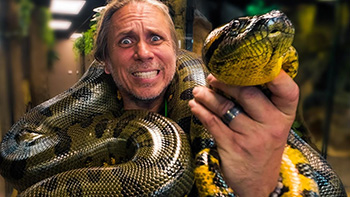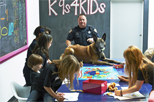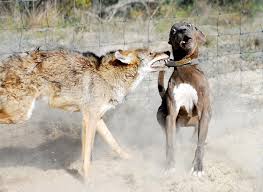Snake-Whisperer Gets The Girls
Brian Barczyk, SnakeBytes TV
 Brian Barczyk loves reptiles. He has over 30,000 snakes. Brian breeds them and sends them all over the globe to his snake-lovin' brethren. He's been bit 100,000 times he estimates and his colorful life is ripe for a TV reality series. Are you listening NatGeo? Oh, and no, he's not single. In fact, the chicks dig it.
Brian Barczyk loves reptiles. He has over 30,000 snakes. Brian breeds them and sends them all over the globe to his snake-lovin' brethren. He's been bit 100,000 times he estimates and his colorful life is ripe for a TV reality series. Are you listening NatGeo? Oh, and no, he's not single. In fact, the chicks dig it.
While Brian tells people he breeds snakes, he actually says he cleans snake poop for a living! He runs one of the world's largest snake breeding facilities, and hatches over 30,000 baby snakes a year! They sell to the beginner hobbyist all the way to the advanced collector. They have snakes as cheap as $25 all the way up to $125,000 a piece.
While Brian doesn't name all of his snakes; he does have two mascots that he has named. One is called Satan and the other is Sunshine. He says they couldn't be more of polar opposites, both good and evil.
Brian ships his snakes all over the world to countries that allow export. However, Brian said it is a lot easier to ship them in the United States. The U.S. has made it so easy, all you have to do is to go to his website, click on a snake, and it will be at your doorstep the next day.
But all snakes are not legal in all places. For instance, New York might have a law against snakes over 6 feet. So anything that can grow to 6 feet or larger, can't be shipped to them.
The majority of Brian's snakes are corn snakes, king snakes and ball pythons, all snakes that don't grow any larger than 3 to 5 feet. Brian says these snakes make really great pets, and over the last 20 years they have become more mainstreamed.
Brian blames his mom for his 30,000 snakes, because as a kid he would collect garter snakes and try to bring them into the house. It wasn't until he was fifteen when he got his first pet snake that he could keep at home. He feels if he could have gotten it out of his system when he was a kid, he might not be surrounded by thousands of snakes today.
Feeding that many snakes is not easy. They go through more than 250,000 rodents per year, at a cost of over $200,000.
Brian says he has been bitten over 100,000 times, which is just part of the daily routine. Fortunately, one of the things he has been grateful for is that he has never been to the hospital for a bite, even though there may have been a handful of times where he broke out the super glue and bandaged himself. Brian says 18-foot pythons have tagged him, and in fact, his snake named Satan, who is 200 pounds and 18-feet long, has bit him four times.
When asked what is the most poisonous snake that Brian has, he corrected us and said they were not poisonous but venomous. Brian doesn't keep any venomous snakes in his facility, but does work with them for film projects, which included tiger snakes and king cobras. Brian has a staff of about twelve and doesn't feel comfortable putting them in a position where they have to handle something that could potentially kill them. Brian tells us even his wife works along side him, and that when they met, she was terrified of snakes!
Who buys his snakes? People who want to breed snakes on their own, as well as musicians, athletes and high profile celebrities. If a celebrity wants a really cool animal, they usually go to guys like Brian. Some celebrities that have purchased snakes from Brian are Leonardo DiCaprio and Nick Cage.
While Brian does work with snakes for film and television, he is still a true snake breeder at heart.
Visit Website
Security K9's For Schools
Mark Gomer, School Protection Dogs
 Following the Sandy Hook tragedy, Mark Gomer, who has trained thousands of dogs over 20 years, got the idea to put Canine Protection Dogs into schools to sniff-out firearms and diffuse violent situations. At around $50,000 per dog, Mark tried to convince schools to purchase one of these full-time K9's to protect their students.
Following the Sandy Hook tragedy, Mark Gomer, who has trained thousands of dogs over 20 years, got the idea to put Canine Protection Dogs into schools to sniff-out firearms and diffuse violent situations. At around $50,000 per dog, Mark tried to convince schools to purchase one of these full-time K9's to protect their students.
But in a case like Sandy Hook with a shooter, wouldn't a dog be in as much danger as the children, and couldn't the shooter shoot them as well? Mark explains that that is always a possibility, but that these dogs are fast and agile. In a situation like that, there is going to be a lot of chaos and the shooter is not necessarily going to be focused on the dog. It is the dog's job to create an obstacle, to create a problem for the shooter, and these dogs have been trained for this. If anyone were to come in shooting, the dogs have been put through much training, and they know who they are supposed to take out.
These dogs are also trained to search for drugs and firearms in lockers and backpacks. The kids are also aware that now someone is going to be searching them and their lockers on a daily basis. They dogs also learn on the job about marching bands and school bells and the thunk of books hitting a locker.
The dogs are handled by someone full time on the premises. In some cases, the principal as well as the hall monitor handle the dog. The dog goes home with and lives with one of the handlers when he is not at the school.
These dogs are not usually too distracting to the students, as many schools currently have assistance dogs in attendance with the students. While there may be some students who are allergic to dogs, it would be known ahead of time, so the dogs would stay clear.
Schools are actually purchasing these dogs, so the dog becomes part of the school staff; they are there all day long and all week long. Of course, most school systems don't have the funding for a purchase like this, so where does the money come from? It costs around $50,000 and is a 2-year process. Once these dogs are in school, they should be able to work for around 8 years. Broken down it is very inexpensive when you compare it to other options, such as the hiring of an armed guard. It would cost around $75,000 per year every year to hire a guard, where this is a one-time purchase for around 8 years. Schools are able to do fund raising and apply for grants to make one of these dogs possible.
Schools should be one of the safest places for our children, but right now it is the opposite!
Visit Website
Coyotes Stalking our Neighborhoods - Dr. Debbie
 I saw a scraggly coyote in front of my house one morning - the second coyote sighting in my neighborhood in a week. I feared what could have happened if my 15 pound terrier was outdoors alone. Wildlife is beautiful, but when my little terrier, Boss, is in harm's way - my doggie momma protective instincts kick in. While not a threat to be exaggerated, the coyote nonetheless poses a risk to our pet's safety.
I saw a scraggly coyote in front of my house one morning - the second coyote sighting in my neighborhood in a week. I feared what could have happened if my 15 pound terrier was outdoors alone. Wildlife is beautiful, but when my little terrier, Boss, is in harm's way - my doggie momma protective instincts kick in. While not a threat to be exaggerated, the coyote nonetheless poses a risk to our pet's safety.
Coyotes are increasingly becoming a concern in urban areas - some are displaced by the urban sprawl that consumes their potential habitat. But other coyotes become urbanized savvy to living, feeding and thriving within city environments. Coyotes are born opportunists and dine on what they find available. They eat small animals like rabbits and rodents, but also consume ample vegetable matter with up to 40-percent of their diet consisting of seeds, grasses, fruits and flowers.
The most serious coyote concern for pets is injury and predation. As a veterinarian, I can recall many a client whose pet was brought in injured by unknown wildlife or whose cat just one day reportedly just vanished. While many might believe their cat was stolen, in reality these cats most likely fell victim to coyote predation. Likewise, small to medium sized dogs can be injured or lost to the same fate as their feline counterparts.
Steps to Keep Your Pet Safe
Whether you have pets or not, it's important not to feed coyotes. Intentional feeding of coyotes makes them dependent on humans and less fearful, which increases the chance of an unwanted, dangerous interaction with people or pets. Just leaving unsecured garbage is invitation enough for these opportunists. Secure all garbage in closing containers and avoid leaving bagged garbage at the curb overnight. Pick up uneaten pet food as soon as your pet has finished eating.
Pet owners should take precautions to keep their household pets protected as well. Keep cats indoors and maintain all pets on leash control when outdoors. Ensure your dogs and cats are up to date on their rabies vaccines. Even indoor cats that do not venture outdoors should be current on this vaccine for both pet and human safety.
 Besides rabies, keep your pets current on other vaccinations, deworming and preventatives as recommended by your veterinarian. Coyotes are known to harbor carry skin mites, canine distemper virus, canine parvovirus, adenovirus and heart worm disease. So even if your dog never leaves your yard, there is potential for infectious disease crossover between wildlife and your pet.
Besides rabies, keep your pets current on other vaccinations, deworming and preventatives as recommended by your veterinarian. Coyotes are known to harbor carry skin mites, canine distemper virus, canine parvovirus, adenovirus and heart worm disease. So even if your dog never leaves your yard, there is potential for infectious disease crossover between wildlife and your pet.
These wild canids are masters at adapting to their changing world, and it's unrealistic they are going away on their own. As humans we are the ones that need to change to make urban areas less appealing, removing easy feeding sites, and by raising awareness to the potential crossover between wildlife and pets.
Featured veterinarian known as "Dr. Debbie" on national pet radio program, Animal Radio. Ebook author of "Yorkshire Terriers: How to Be Your Dog's Best Friend"; "Pugs: How to Be Your Dog's Best Friend"; "Mini Schnauzers: How to Be Your Dog's Best Friend"; and "Shih Tzu: How to Be Your Dog's Best Friend." Dr. Debbie's books.
Visit Website
Animal Radio News with Stacey Cohen
 Pig Rally
Pig Rally
Pigs previously rallied outside the Italian parliament, all because farmers were upset about so-called fake salami that wasn't made in Italy. The farmers brought the pigs to the city as an act of protest. Italian farmers paraded small, pink pigs in protest outside parliament, declaring they were being driven to ruin by hams and salami sold as "Made in Italy" but produced largely elsewhere. The agriculture sector has long been in decline in the euro zone's third largest economy and farmers said it is undermined by counterfeit products and low quality foreign food that is merely processed in Italy. The farmers urged passers-by to "adopt" one of the pigs. The group said the meat production industry provides 105,000 jobs in an economy where unemployment is at a record high, and launched a campaign to encourage Italians to buy national products.
Chef Poisoned While Preparing Snake Meat
A chef in China was poisoned while preparing a meal of snake meat. He was cutting the head off of a cobra at a restaurant in China when the snake's venom hit him in the face. Doctors later explained that the venom can enter someone's bloodstream through the eyes or cuts, which explained why the chef's eyes immediately started hurting and his lower jaw began to swell. He was rushed to a nearby hospital where doctors were able to save him with timely treatment.
 Buddha Died From Heart Failure
Buddha Died From Heart Failure
Buddha the obese gray and white cat whose diet and exercise plan made him a viral sensation, died of congestive heart failure. He was 6 years old. The cat inspired people around the world with his jaunts on an underwater treadmill, which along with a diet plan, helped him whittle down his 31.4-pound weight. Buddha was dropped off at Animal Control in Nashville after his owner died. Realizing the overweight cat's health was at risk, volunteers took Buddha to Cat Shoppe, where the feline began his weight loss journey. Video of the fat cat working out on his special treadmill was shared around the world and made Buddha a celebrity.
There's An App For That
Ever wonder where you can take your dog if you are out and about? The Fido Factor app lets people know which places allow dogs, whether it's a department store, restaurant, bar or just about any place else. In addition, the app gives you specific rules for each place, so you'll know things like the leash rules or the fees you'll have to pay. And, if you find a new location that allows dogs, you can add it to the app's FaceBook page to let others know where it is, and you can even write a review to let others know if it's truly dog friendly or not. Plus, you can read reviews of each location to see if it's worth bringing your dog there, because just because a place says it allows dogs, it doesn't necessarily mean that it's a great place for your dog to be. To find a dog-friendly location you can either search by business name or type of location and get things like directions, hours of operation and the place's phone number. And, FidoFactor allows you to take photos of your dog at these locations and upload them for other users to see and comment on.
 Listen to the entire Podcast of this show (#1207)
Listen to the entire Podcast of this show (#1207)





